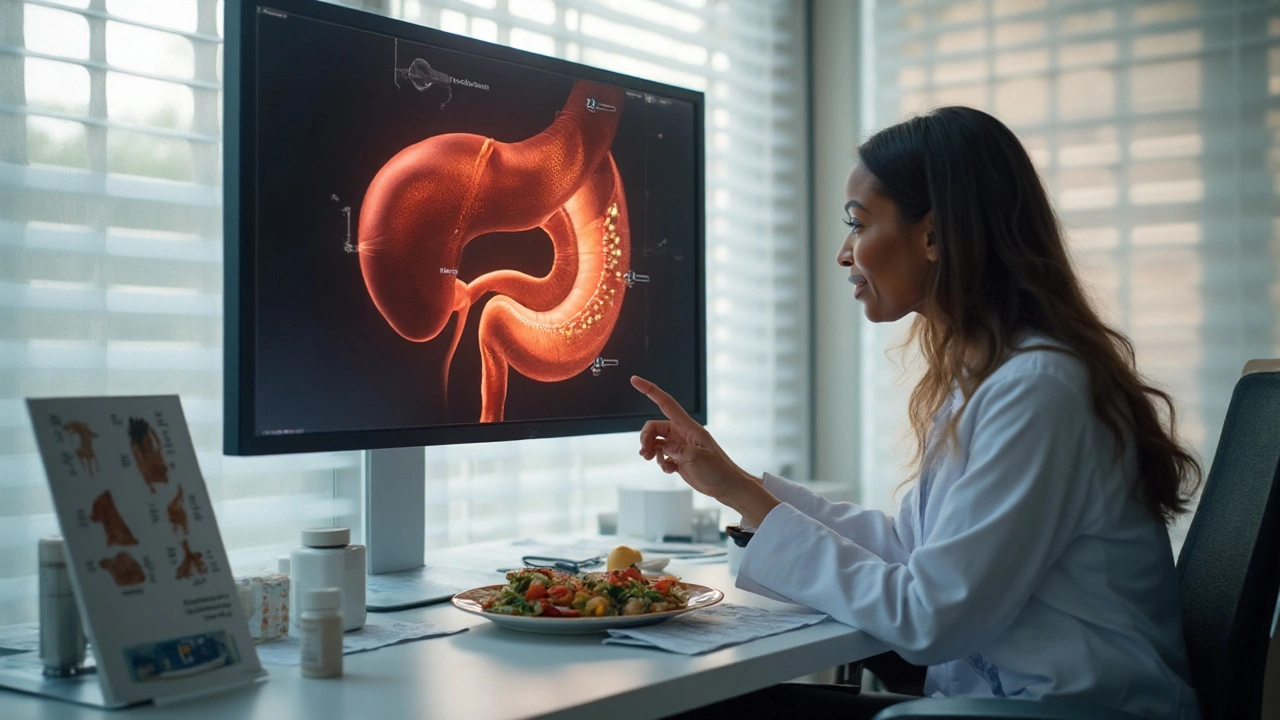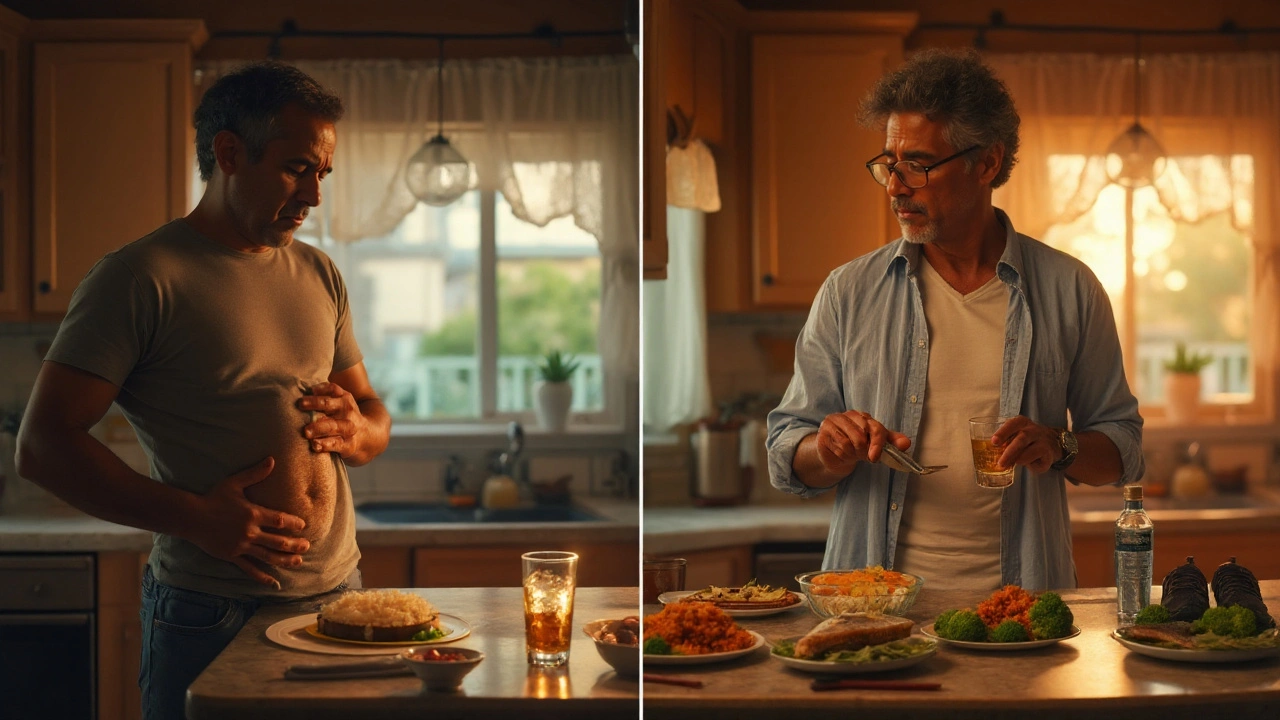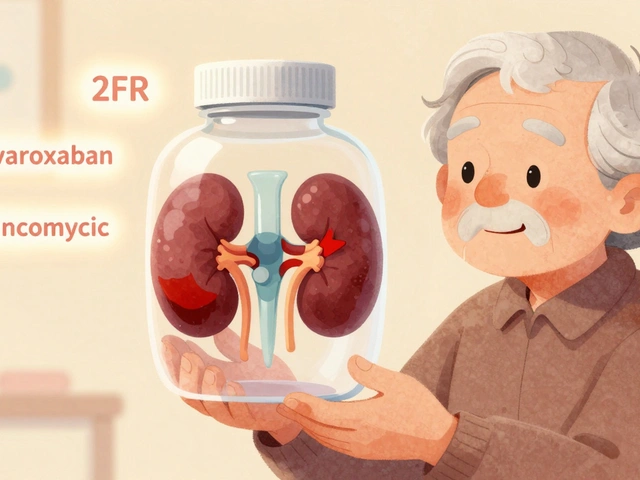
TL;DR
- Long-standing duct blockage raises pressure inside the pancreas, causing acinar cell loss, scarring, and nerve changes that reduce both digestive enzyme output and hormone release.
- Expect a drift from pain to maldigestion (steatorrhea, weight loss) and later to pancreatogenic (type 3c) diabetes. Some function can recover if you relieve the blockage early.
- Best tests: MRCP/EUS for the ducts and lesions, fecal elastase for exocrine function, and fasting glucose/HbA1c or OGTT for endocrine function.
- Core care: fix the blockage (endoscopic or surgical), replace enzymes (PERT), nourish aggressively (vitamins A, D, E, K; protein), and manage diabetes with an endocrine plan.
- Red flags needing urgent action: jaundice, recurrent pancreatitis, rapid weight loss, new-onset diabetes in an older adult, or an abrupt change in pain pattern.
When the main pipe that drains the pancreas narrows or plugs, pressure builds. Over months to years, that pressure and inflammation chip away at the gland’s two jobs-digestion and blood sugar control. Think of it as three phases that can overlap: pain from ductal hypertension, then maldigestion from enzyme loss, and finally glycemic swings from hormone loss. Some of this damage is reversible, especially if you catch and relieve the obstruction before scarring sets in.
What a blocked duct does: from pressure and inflammation to enzyme and hormone loss
The pancreas is a factory sitting on a single conveyor belt. If that conveyor-its duct-slows or stops, the upstream factory floors (acini) back up, get stressed, and start shutting down. That’s the core of pancreatic duct obstruction.
Here’s the chain reaction most people don’t see:
- Ductal hypertension: fluid can’t escape, pressure rises, and acinar cells get squeezed.
- Inflammatory cascade: injured acinar cells release enzymes and cytokines; pancreatic stellate cells activate and lay down collagen. Scar-that is, fibrosis-locks in dysfunction.
- Neural rewiring: pain persists even after the original insult because nerves in and around the pancreas become hypersensitive.
- Functional decline: first exocrine (enzymes), then endocrine (insulin, glucagon). The order varies by cause and person.
Common causes that block the duct long term:
- Stones/strictures in chronic pancreatitis (often alcohol, smoking, genetic variants like PRSS1, SPINK1, CFTR).
- Benign strictures after severe pancreatitis or surgery; disconnected pancreatic duct syndrome after necrosis.
- Tumors (especially in the head of the pancreas) and main-duct intraductal papillary mucinous neoplasms (IPMN) that congest the duct with mucin.
- Congenital variants (pancreas divisum) with a tight minor papilla in a subset of people.
What this looks like over time:
- Pain and flares of pancreatitis early on, often after meals or alcohol, improving temporarily with decompression.
- Steatorrhea (pale, floating, hard-to-flush stools), bloating, weight loss, muscle wasting, and fat-soluble vitamin deficiency as enzyme output drops.
- Metabolic shift to type 3c diabetes-erratic blood sugars with a higher risk of hypoglycemia because glucagon-secreting alpha cells can also be impaired.
| Long-term effect | Mechanism | Typical time course | Markers to track | Approx. frequency with chronic obstruction |
|---|---|---|---|---|
| Exocrine pancreatic insufficiency (EPI) | Acinar atrophy + ductal scarring lower enzyme delivery to gut | Months-years; sooner with main duct strictures or cancer | Fecal elastase <200 µg/g; weight/BMI; vitamins A, D, E, K | Common (50-80% over years in chronic pancreatitis cohorts) |
| Type 3c diabetes (pancreatogenic) | Loss of insulin and glucagon secretion; hepatic insulin resistance | Years; faster with calcific disease or resection | Fasting glucose, HbA1c, OGTT; hypoglycemia events | Frequent (30-50% over a decade, higher after surgery) |
| Chronic pain syndrome | Ductal hypertension + neural sensitization | Early and persistent; may outlast obstruction | Pain scores; opioid exposure; quality-of-life scales | Frequent; varies by cause and timing of decompression |
| Pancreatic atrophy | Progressive fibrosis and cell loss | Months-years | MRI/CT volume; EUS texture; rising duct diameter | Common in untreated obstruction |
| Nutrition & bone issues | Fat malabsorption → vitamin D/K deficits; sarcopenia | Parallel with EPI | 25‑OH vitamin D; INR; DEXA if at risk | Under-recognized; screen proactively |
What’s reversible? Pain from pressure often improves quickly after drainage. Enzyme output can partially recover if fibrosis isn’t established. Endocrine recovery is less predictable: some people stabilize, but long-standing endocrine loss usually needs medical therapy. Multiple guidelines (AGA 2020 update; IAP/APA consensus) echo the same big idea: earlier, durable ductal decompression preserves more function than late, piecemeal care.

How to detect, monitor, and fix the blockage-then protect function
If the goal is to save function, think in this order: find the blockage, relieve it, then support what’s left.
Find the blockage (and its cause):
- MRCP (often with secretin): painless, noninvasive, and great for mapping strictures, stones, and duct caliber.
- EUS: best for small tumors, subtle stones, and tissue diagnosis via fine-needle biopsy if needed.
- CT pancreas protocol: shows calcifications, atrophy, mass effect, and complications.
- ERCP: therapeutic tool, not just a test-use it when you plan to intervene (sphincterotomy, stone extraction, stenting).
Assess pancreatic function right away and over time:
- Exocrine tests: fecal elastase <200 µg/g suggests EPI; <100 is severe. If diarrhea is watery, repeat the test-dilution can yield false lows.
- Nutrition labs: vitamins A/D/E/K, prealbumin or albumin, magnesium, calcium, INR (vitamin K proxy), B12/folate if symptoms suggest.
- Endocrine: fasting glucose and HbA1c; consider an oral glucose tolerance test if borderline. Watch for “brittle” swings and frequent hypos.
Relieve the obstruction (what usually works):
- Endoscopic therapy for strictures and stones: ERCP with pancreatic sphincterotomy; balloon dilation; plastic or metal stents. Combine with ESWL (shockwave) for large duct stones in chronic pancreatitis.
- Resection or bypass for tumors: pancreaticoduodenectomy (Whipple) or distal pancreatectomy depending on location; oncologic pathway if cancer is confirmed.
- Drainage procedures for chronic head-dominant disease: Puestow (lateral pancreaticojejunostomy) or Frey (local head resection with drainage) give durable duct decompression and can cut down pain flares.
- Disconnected duct after necrosis: endoscopic transmural drainage with long-term indwelling stents, or surgical reconstruction if symptoms persist.
Support what the pancreas can’t do (the everyday stuff that preserves weight and energy):
- Pancreatic enzyme replacement therapy (PERT): start at 40,000-50,000 units lipase with meals and 20,000-25,000 with snacks; take half at the start and the rest mid‑meal. If symptoms persist, double the dose or add a PPI to reduce acid inactivation.
- Fat-soluble vitamins: replace A/D/E/K; repeat levels every 3-6 months until stable. Add calcium and vitamin D for bone protection.
- Nutrition: aim for 1.2-1.5 g/kg/day of protein during recovery; consider a dietitian referral early. In Australia, PERT is PBS‑listed-ask your GP or gastroenterologist about streamlined authority if needed.
- Pain plan: start with non-opioid options; consider endoscopic or surgical decompression earlier rather than escalating opioids. A pain team can help with neuropathic features.
- Diabetes (type 3c) care: metformin if tolerated; insulin is common as disease advances. Watch for hypos-glucagon response can be blunted. Involve an endocrinologist.
Follow-up that actually catches decline:
- Every 3-6 months in the first year after decompression, then yearly if stable: weight, symptoms, fecal elastase (if borderline), vitamins A/D/E/K, HbA1c, and a check for hypos.
- Imaging at 6-12 months if there was a mass, high‑grade stricture, or persistent duct dilation; sooner if new red flags appear.
- Bone health: DEXA if you’ve had prolonged EPI, vitamin D deficiency, or steroid exposure.
Heuristics you can use right away:
- The 3‑R rule: Relieve obstruction, Replace enzymes, Reduce risks (smoking, alcohol, malnutrition).
- 50-20-2 rule for EPI: 50,000 lipase per main meals, 20,000 per snacks, 2‑week reassess. If still steatorrhea, increase dose or add PPI.
- Don’t wait for weight loss: a fecal elastase under 200 plus classic stools is enough to start PERT while you chase the cause.
- Red flags = imaging now: painless jaundice, new-onset diabetes after 50, or rapidly worsening pain-move to MRCP/EUS promptly.

Living with and preventing long-term damage: practical tips, pitfalls, and common questions
Protecting function is a long game. The day-to-day wins-enzyme timing, meal choices, stopping smoking-add up. Here’s how to stack the odds in your favor.
Food, enzymes, and symptoms: make them work together
- Time enzymes with food: start of the meal, then mid‑meal for bigger plates. If you graze, carry a small dose for each snack.
- Don’t fear fat, dose for it: PERT is there so you can absorb fat. If you’re still seeing oily stools, you’re underdosed or need acid suppression.
- Hydration and fiber: enough water and moderate fiber can cut cramping and improve stool form. Extremely high fiber can bind enzymes-balance it.
Diabetes specifics in type 3c (what’s different):
- Higher hypo risk: loss of alpha cells blunts glucagon, so have a hypo plan (glucose tabs, clear sick‑day rules).
- Watch malabsorption: poor absorption can make oral diabetes meds look “weak” and make glucose swings unpredictable. Fix EPI first-it stabilizes sugars.
- Tech helps: CGMs (continuous glucose monitors) spot silent hypos. If you’re in Australia, ask about PBS or private coverage criteria for CGM.
Pitfalls that derail recovery:
- “Normal” stools on bad enzymes: stools can look fine and still be malabsorptive. Trust weight, energy, and vitamin levels, not just appearance.
- False lows on fecal elastase with watery diarrhea: repeat with a formed sample before escalating therapy.
- Prolonged stents without a plan: pancreatic stents often need exchanges every 3 months; set reminders so you don’t end up with stent occlusion or infection.
- Assuming pain = inflammation: once nerves reset, pain may linger even with a decompressed duct. That’s a cue for a pain team, not just more procedures.
Smoking and alcohol: the non-negotiables
- Smoking accelerates fibrosis and doubles down on cancer risk. Stopping slows the slide.
- Alcohol is a trigger for attacks and pain. If you can’t stop, get help-brief interventions, meds, and support programs work better than white‑knuckling it alone.
What the evidence says (in plain English)
- Guidelines from the American Gastroenterological Association and the IAP/APA agree: early, durable ductal decompression improves pain and may preserve exocrine function when done before fixed fibrosis sets in.
- Chronic pancreatitis cohorts show high rates of EPI and diabetes over time; those who stop smoking and maintain weight do better.
- After cancer-related obstruction, decompression treats symptoms but doesn’t change tumor biology-oncology drives the outcome there.
Mini‑FAQ
- Can pancreatic function recover after the blockage is fixed? Some can. Pain should improve quickly. Enzyme output may bounce back partly if you intervene before heavy scarring. Endocrine recovery is less common but stabilization happens.
- How long does it take to develop EPI? It varies. With chronic strictures or stones, months to a few years. With a head‑of‑pancreas tumor, maldigestion can appear within months.
- Is fecal elastase reliable? It’s a good screening test. It can be falsely low in watery stools; repeat with a solid sample. Direct function tests exist but are rarely used outside specialized centers.
- Will stents fix my diabetes? Unlikely. Stents relieve pressure and pain; they don’t regenerate lost islets. You still treat diabetes on its own merits.
- Is PERT lifelong? If the cause is removed early and function rebounds, you might taper. Many people with chronic changes stay on it long term.
- Does a blocked duct raise cancer risk? Long-standing chronic pancreatitis carries a higher risk. Main-duct IPMN has a higher malignancy potential and needs specialist follow-up.
Checklists you can print or screenshot
Symptoms and signs that point to EPI despite “ok” lab numbers:
- Weight loss or halted weight gain despite normal appetite
- Oily, foul, floating stools that stick to the bowl
- Bloating after fatty meals
- Fat‑soluble vitamin deficiency (low vitamin D or bruising from low vitamin K)
Your first‑month plan after decompression:
- Start PERT at meal/snack doses; add a PPI if symptoms persist after 2 weeks
- Order/track vitamins A/D/E/K and 25‑OH vitamin D; supplement
- Set reminders for stent exchange if one was placed (often at 3 months)
- Book a dietitian and diabetes check (fasting glucose/HbA1c)
Decision tips: endoscopy vs surgery
- Endoscopy fits best when there’s a focal stricture or stones you can clear, or when you’re not a surgical candidate.
- Surgery makes sense if ducts are widely dilated with multiple strictures, there’s an inflammatory head mass, or endoscopy has failed repeatedly.
- Ask one simple question: will this option give me durable, low‑maintenance drainage?
Next steps and troubleshooting by scenario
- If you have new painless jaundice or new diabetes after 50: act now-book urgent imaging (MRCP/EUS) to rule out a head‑of‑pancreas mass.
- If you’ve had recurrent pancreatitis with a known stricture: discuss early decompression instead of repeating hospital stays.
- If you’re on enzymes but still symptomatic: check dose and timing, add a PPI, and re-test vitamins. Consider SIBO if bloating dominates.
- If your stent was placed more than 3 months ago: confirm the exchange plan-overdue stents can block or migrate.
- If weight is falling despite treatment: escalate nutrition support (high‑energy oral supplements; consider enteral feeds) and screen for depression and pain‑related anorexia.
When to loop in subspecialists
- Advanced endoscopy for complex stones/strictures or disconnected duct issues
- Pancreatic surgeon for durable drainage procedures or when cancer is on the table
- Endocrinology for brittle type 3c diabetes or frequent hypos
- Pain service for neuropathic pain after decompression or opioid-sparing strategies
One last nudge from someone who’s seen a lot of this in clinic here in Australia: the biggest gains come from doing the “boring” basics every day-enzymes on time, smoke‑free, nutrition dialed in, and scheduled follow‑ups-while pushing for early, definitive decompression rather than living from flare to flare. That’s how you keep more of your pancreas working for more of your life.






16 Comments
Oh, marvelous – another 20‑page medical dissertation that makes my brain feel like it’s doing burpees. I mean, who needs a simple explanation when you can drown in fancy jargon and tables? It’s not like anyone actually reads this stuff unless they’re training to become a pancreas‑whisperer. And sure, let’s throw in every abbreviation known to humankind, because clarity is overrated. If you wanted a bedtime story, you’d have picked a fairy tale, not a pancreatic textbook.
People think this is just about stones and stuff – nah, it’s a cover‑up. The big pharma and the gov't are hiding the real cure, they plant "duct obstruction" info to keep us buying endless meds. If you look deeper, the pattern shows a push for surgery that lines their pockets. Wake up, the system wants you dependent.
Honestly, this articl is way to ovrecomplicated. The author could have said "stop drinkin and smoke" and save us all the lipase dosage math. Typos aside, the core mesage is simple: get the blockage fixed early or suffer forever. Stop making it sound like rocket science.
Hey folks, if you’re dealing with a blocked duct, remember you’re not alone. Start by getting a proper MRCP to map out the issue, then discuss endoscopic versus surgical options with your gastro team. In the meantime, PERT can really help with the steatorrhea – try 40,000‑50,000 units of lipase with each main meal and adjust based on symptom control. Keep an eye on your vitamin D, A, E, and K levels, and supplement as needed. And most importantly, quit smoking; it slows fibrosis and improves outcomes. You’ve got this!
From a pathophysiological standpoint, the obstruction precipitates intraductal hypertension, culminating in acinar atrophy and subsequent exocrine insufficiency. Concurrently, islet cell compromise precipitates type 3c diabetes. Early decompression mitigates fibrotic cascade activation, preserving residual endocrine reserve.
Look, the evidence is crystal clear: delayed intervention translates into irreversible fibrosis, which means you’ll be stuck on lifelong enzyme therapy and insulin. The timing of ERCP or surgical drainage is critical – the sooner you relieve that pressure, the better the chance of preserving both exocrine and endocrine function. Don't wait for the pain to become chronic; act now.
Great summary! 👍
Folks, here’s the practical checklist: 1) Get imaging – MRCP with secretin is gold. 2) If a stricture is seen, consider ERCP with stent placement. 3) Start PERT immediately – 40‑50k units lipase per main meal, 20‑25k for snacks. 4) Monitor fecal elastase and vitamin levels every 3‑6 months. 5) Schedule glucose/HbA1c checks – type 3c diabetes can be sneaky. Follow these steps and you’ll keep your pancreas working as long as possible.
Alright team, let’s keep this friendly and inclusive. If you’re uncertain about whether endoscopy or surgery is right for you, talk to a multidisciplinary clinic – they’ll look at your imaging, symptoms, and overall health to craft a personalized plan. It’s not a one‑size‑fits‑all situation, and a supportive environment makes the journey smoother.
Hey, I totally get the need for a team – but don’t forget to ask your doctor about diet hacks too. I’ve heard that adding a splash of pineapple juice can help enzyme activation, weird but worth a try.
When you look at the cascade that follows a chronic pancreatic duct obstruction, the first element to consider is the intraductal pressure increase, which physically compresses the acinar cells, leading to cellular apoptosis, and this in turn reduces the secretion of lipase, amylase, and proteases, all of which are essential for normal digestion; next, the inflammatory response is activated, with cytokines such as IL‑6 and TNF‑α propagating a fibrotic environment, which further narrows the ductal lumen, creating a vicious feedback loop that accelerates tissue scarring; additionally, the stellate cells become myofibroblastic, depositing collagen, and the resulting fibrosis not only hampers exocrine function but also impinges on the islet cells, compromising insulin and glucagon output; the clinical picture evolves from episodic epigastric pain, often post‑prandial, to chronic steatorrhea, marked by oily, foul‑smelling stools, weight loss, and deficiencies in fat‑soluble vitamins A, D, E, and K; laboratory markers will eventually reveal low fecal elastase, low serum albumin, and possibly elevated fasting glucose or HbA1c, indicating the transition to type 3c diabetes; imaging modalities such as MRCP with secretin, endoscopic ultrasound, and contrast‑enhanced CT provide detailed anatomical and functional assessment, allowing the clinician to distinguish between obstructive stones, strictures, or neoplastic lesions; therapeutic interventions focus on relieving the obstruction via ERCP with stone extraction and stenting, or, when appropriate, surgical drainage procedures like Puestow or Frey, which have shown durable symptom control and modest preservation of pancreatic tissue; concomitant medical management includes pancreatic enzyme replacement therapy, titrated to the fat content of meals, supplementation of vitamins D, A, E, K, and the use of PPIs to protect enzyme activity in the acidic gastric environment; for patients who develop endocrine insufficiency, a tailored diabetes regimen-often beginning with metformin and progressing to insulin as beta‑cell reserve wanes-is essential to prevent hypoglycemic episodes, especially given the blunted glucagon response; regular follow‑up every three to six months in the first year, then annually, with repeat imaging, nutritional labs, and glycemic monitoring, helps catch disease progression early; finally, lifestyle modifications-smoking cessation, alcohol moderation, and a balanced diet rich in protein and low in simple sugars-are non‑negotiable pillars that slow fibrosis and improve overall prognosis.
The data clearly show that early decompression correlates with better preservation of both exocrine and endocrine function, underscoring the importance of timely intervention.
In response to the comprehensive overview, it is evident that a systematic, step‑wise approach-imaging, intervention, enzyme replacement, and metabolic monitoring-offers the most pragmatic pathway to managing chronic duct obstruction while minimizing complications.
From a mechanistic perspective, the obstruction initiates a biomechanical stress response that activates a cascade of cellular signaling pathways, notably the TGF‑β mediated fibrogenic axis, which inexorably leads to extracellular matrix deposition and parenchymal loss; this pathological remodeling not only diminishes digestive enzyme output but also disrupts the finely tuned islet architecture, precipitating a dysregulated glycemic milieu characteristic of type 3c diabetes; therefore, therapeutic strategies must address both the hemodynamic relief of ductal pressure and the molecular attenuation of fibrotic signaling to achieve holistic preservation of pancreatic physiology.
The philosophical framing you provide aligns with the clinical reality: without early mechanical correction, the downstream biochemical derangements become entrenched, making any later intervention merely palliative rather than restorative.
Keep your chin up, you’ve got a solid plan and a supportive team – remember to celebrate the small wins! 😊